I am rather excited to have this one in my hands, as it really does hold a special place in the range of ukuleles out there. It's also a ukulele I have wanted to own for quite some time. Hello to the tenor scale resonator ukulele made in the UK by Beltona musical instruments.
Look at it.... just LOOK AT IT!! Sorry.. sorry.. I am getting ahead of myself - but seriously - just LOOK AT IT! OK, back to the review...
Beltona was the brainchild of Steve Evans who started making instruments in partnership with Bill Johnson in 1990 and since then has developed an enviable following amongst musicians who appreciate good quality. Steve started building them in the UK, moved to New Zealand where he continued to make them and has since returned to the UK again. Well known owners of Beltona instruments include Jake Shimabukuro, James Hill, Peter Brooke Turner of UOGB, Mark Knopfler and at one point Tiny Tim (who's actual Beltona instrument is now owned and played by Tim Smithies in the band Dead Mans Uke). Quite a roster I am sure you will agree!
I've not reviewed a lot of resonators on this site, but I have played quite a few. ( I don't write fleeting reviews without proper time spent with an instrument, reviews of instruments via Amazon reports or 'across the room' reports - I will leave those to other websites..) But based on the examples I have played, something I have said publicly about resonators is this. If ever there was an example of a ukulele where you benefit from spending more or sensible money, it's with resonators. As such, whilst there are indeed many resonator ukes out there for the low hundreds of pounds in price, they have all left me a little flat with their tone and quality control. A kind of 'what is the fuss all about' feeling. Then, at a ukulele festival back in 2013, I was chatting with Phil Doleman who had just bought a Beltona and let me have a play of his. I had played a few resonators by this point and was not 'getting' it. Those I had played had not impressed me, but I was completely blown away by the sound of Phils and have been hankering for one ever since. In fact, I played Phils Beltona back to back with a National reso ukulele at that event (probably the most famous resonator name on the planet) and far, FAR preferred the Beltona! That very statement will likely enrage some National fans, but there you go.
As I say, Steve is now based in the UK in Birstall, about halfway between Huddersfield and Leeds and makes these instruments by hand. The first thing that differs with a Beltona is that resonators tend, in the main, to be made of either metal (with brass bodies, usually nickel plated - think 'Brothers In Arms' album cover and the guitar reso made so famous by Dire Straits) or traditional wooden bodies. Each of then employ a cone or range of cones (the resonator bit that can differ) set into the body to amplify the sound. Where the Beltona differs the most these days though is that their bodies are made from glass fibre resin. Steve used to make metal bodied instruments, but has not done so for some time, preferring the resin option. Not only is this extremely strong, but they are also much lighter than brass bodied resonators, and Steve claims they have improved sound projection also.
A quick break to go back to basics for a little while - what is a resonator? Well, generally speaking it's a non electric ukulele that uses a spun cone under the bridge to amplify the sound naturally. Think of it as like a metal version of what a banjo does. It doesn't rely on a wooden sound chamber and sound hole like most acoustic ukuleles to project the sound - it uses a natural, metal cone 'amplifier' to do that. In other words a musical instrument that uses another feature to make a louder sound - originally developed in guitars in the days before affordable amplifiers, or for people to play into microphones. They have a distinctive, old time bluesy sound that many people adore. They can have more of an attacking sound than a straight acoustic and like a banjo without the 'melt your ears off' punch that banjoleles seem to possess.
So this Tenor is known as the 'Songster' model and is one of two types of tenor made by Steve. The type 2 like this one has the rather attractive sweeping cutaway you can see in the photos, whereas the type 1 has a standard double bout shape. According to Steve, the sound from each is the same, so the choice is one of aesthetics. I really like the look of it myself as I like things that are a little different. I mean - just look at it!! The sweep of that cutaway is just sublime to my eye, and perfectly offset by the opposite sweep on the other shoulder which also runs contrary to what you may expect from a traditional double bout. I am not sure of the best way to describe it but it kind of gives it a '1950's space age' feel. The base of the ukulele is more standard in shape. I sourced this one through Southern Ukulele Store, but they can also be ordered direct from Beltona.
The body, as I say, is made from glass fibre resin and is finished with a painted coating in a high gloss finish. The look and finish of the instrument really is pretty much flawless all over. Beltona label it as an 'automotive finish' and I can see why - it does make you think that the instrument was made from steel and finished in a car plant spray shop - glossy, shiny and solid looking! Occasionally you see one or two bubbles or application marks, but I quite like that in the same way I like tooling marks showing on hand made wooden ukuleles. Put more simply, I don't like absolute perfection as that tends to be the mark of a faceless factory build. This was built by Steve, not a cheap labour force. The finish is not overly thick either and you can see that when you inspect the edges, hollows and the grille of the resonator. There is no pooling or build up of the finish anywhere on the instrument.
The body is essentially all one piece with a cavity in the top in which to mount the resonator itself. With Beltona you get a custom made aluminium resonator cone made just for them, and here we have one of the key elements that set these apart from cheaper resonators. I am no expert on the science of resonator cones but I know a nice tone when I hear it, and this delivers. More on that later though.
The back is shaped and curved with a kind of hump in it that I think looks really classy. The pictures don't show it off as well as they might, but it's small things like that which set things apart for me.
Covering the resonator is a grilled aluminium cover plate, screwed in place and finished with six diamond shaped drilled colander type vents. The bridge is a biscuit type and the bridge cover is plain. I have seen older Beltonas where the brand name was embossed in the bridge cover. I would have liked that. The 'biscuit' is basically a disc of wood that sits on top of the cone with a wooden bridge saddle on top similar to those on banjos to transfer the vibrations from the strings downwards. The biscuit is the conduit between the resonating cone and the strings and where the magic happens.
Anchoring the strings at the base of the ukulele is a rosewood bridge piece with a couple of mother of pearl dots covering the mounting screws. The whole thing feels solid and oozes hand made quality.
Up to the neck, and this is made of mahogany. The neck I believe runs into the instrument with a pole running through to the base giving it more strength and assisting with resonance. The whole feel of the neck is very nicely done and it has a nice profile and width for my hands. The neck is also finished in gloss which I am not normally a fan of, but it doesn't feel sticky and is fast in the hands. It is a nicely applied gloss which shows how it can be done well.
The fingerboard is topped with rosewood and is flawless and even in colour. We have 19 nickel frets with 12 to the body, and of course that cutaway allows access to all of them easily. Pearl position markers are provided at the 5th, 7th, 10th, 12th and 17th fret spacings with a the 17th being a double dot. The edges are unbound but the fret edges are dressed impeccably. One gripe - no side fret markers!
Up past the nut (which is cut from wood - most likely rosewood or ebony) and we have a really nice headstock for a tenor. No Martin clone here - this is an old time looking headstock that is small and fitted with rear facing friction tuning pegs. Shaping on the top is asymmetric which gives it a vintage feel and is certainly unique. So nice to see something other than a standard three pointed crown shape really. I believe Beltona headstocks do vary, but I really like this one. The way it is carved and sprouts from the neck is just rather beautiful.
Back to the tuners. A note here (as I so often do go on about friction pegs)... These are great quality pegs, and I think they are upper end Grovers or similar (metal parts and washers - i.e. the bits that matter). Anyway, they work brilliantly, turn like butter and don't slip. As I so often say, people should not be afraid of good quality friction pegs. For me they not only work great, but they look great as well. It's a treat for me to see them on a tenor. They just kind of fit the vibe of the instrument.
Elsewhere on the headstock is the Beltona logo which sets the whole thing off very well. It also comes strung with what I think may be Hilo strings. Not sure - but they look and feel like fluorocarbon to me so I suspect the latter. Anyway - they are good quality although you know my views on strings..
And at about £850 retail price, this is clearly not a cheap ukulele and a serious investment. But going back to my earlier comment, I firmly believe that with resonators you get what you pay for. Besides, one of the most famous names in quality resonators, National, make resonator ukuleles and they cost considerably more than this. So as resonators go, I actually think this is actually a reasonable price. On to the play test.
Firstly, the feel of the instrument in the hands is quite sublime I think. It's nicely balanced, and certainly not heavy on the headstock (helped by those friction pegs and small head), or heavy in any way in fact. The whole body is something that makes me want to pick it up and hold it. Since this arrived I can't quite remember cosseting and just 'holding' a ukulele quite as much as this one.
The lack of weight compared to many resonators is extremely welcomed. It feels like it is going to be a resonant instrument in the hands and doesn't feel like a chore to hold, even without a strap. (You may note a strap button in the pictures - that is not standard with Beltona and was added afterwards!).. It just kind of feels alive in the hands when you pick it up. I know that sounds odd, but it's the best way I can describe it
The action at both the nut and bridge is great, spot on in fact. It makes this ukulele one that is fast to play and comfortable in the hands. In fact I would go as far as saying that this is one of the nicest tenor necks I have played. High praise indeed. That setup means that the accuracy all over the fretboard is also spot on. Unlike many ukuleles it also maintains its volume well down the neck.
Volume and clarity across the strings is bold, extremely clear and defined so all looking good so far.
The sound generally? Well, it sounds like a resonator, naturally. It's not the sound of a sweet Koa wood solid instrument, it's a very different thing. But that is not what you are going for with a resonator. The whole point of them is the use of the cone as a kind of in built amplifier. It's about punch and projection. An old time sound if you will without the (forgive me Formby fans) aggressive punch in the face of a banjo. As such it is certainly loud and projects brilliantly but has a more rounded tone which I adore. Yes, it has a metallic tone that is a normal thing with resonators but unlike cheaper models I have played it is a solid, clear tone, and not echoey or rattly (the curse of cheaper resonators). It's hard to describe the difference in words, but you would see what I mean if you play one side by side with a cheaper version.
The punch is clear, but it is not brash. Just the ticket for my tastes!
But it isn't all about amplified volume. Since getting hold of this I have thoroughly enjoyed fingerpicking with it in the living room at low volumes and it performs just as admirably. It seems to adapt and sound comfortable regardless of playing style.
Finally, being a reso I have been tinkering with it using fingerpicks (Alaska Piks as recommended by Aaron Keim) and really enjoying some old time rolls and clawhammer type stuff on it. Now that is not to say this only suits one style of play, it doesn't. It works well with everything, but I do prefer fingerpicking on it. There is something about picking it softly but still getting great projection that I like.
What really stands out for me though is the clarity it has across the strings - every note in a chord rings out clearly right across the dynamic range. Nothing seems to be lost and it never gets muddy. The mark of a well made instrument.
As you have probably gathered by now, I am seriously impressed with this instrument. I don't think a resonator is for every person, but if you are keen on the reso sound, I genuinely think that you would be hard pressed to beat this brand. I know National fans will cry foul on me saying that, but there you go.
Perhaps they are a Marmite tone (US readers - look that up) but they really do seem popular these days as ukulele players look to pad out their collections. I do think though that the vast majority of resonators on the market today are lacking in something when it comes to quality of tone. For me, the Beltona has, thus far, impressed me the most. By far. A staggeringly good instrument.
Beltona website
Be sure to check out my other ukulele reviews here!
UKULELE PROS
Build quality in every departmentLight weight
Sublime neck
Top quality friction pegs
Clear bright rich sound
Just look at it!
UKULELE CONS
No side fret markers...UKULELE SCORES
Looks - 9.5 out of 10Fit and finish - 9 out of 10
Sound - 9.5 out of 10
Value for money - 9 out of 10
OVERALL UKULELE SCORE - 9.3 out of 10
UKULELE VIDEO REVIEW
© Barry Maz

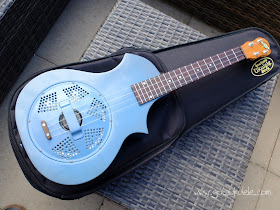




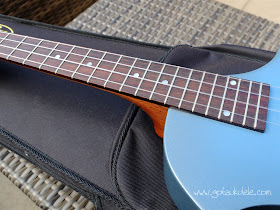
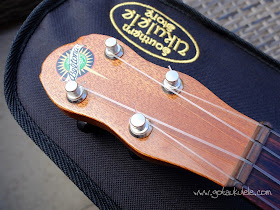
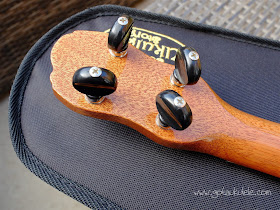
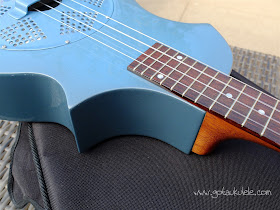
The type 2 is not really a cutaway is it? It's asymmetrical. You couldn't flip over the RHS (looking from above) and fit it into the LHS, could you? The waist on the LHS is higher than on the RHS. Perhaps 'sloping shoulder' would be a more accurate.description of the type 2? Sounds great; though. FWIW, I don't like the asymmetry.
ReplyDeleteI'd say something that has a gap in the body to allow underside access to all of the lower frets is generally accepted as a 'cutaway'. Not sure it has anything to do with it being asymmetrical?
ReplyDeleteGreat review, looks really nice, like you Barry, I wants one!! Great tone to it!
ReplyDeleteIf I look at most ukuleles, or guitars, that are styled as 'cutaway' it's easy to see/imagine what the body would look like if nothing had been 'cut away' from it. And with the cutaway 'filled in', they would look symmetrical. This wouldn't. I kept thinking 'it looks odd', until I realised, it's not really a cutaway. Still; you say tomato...
ReplyDeleteOh, see what you mean - yeah, suppose it is asymmetrical. Still think that is a cutaway though! ;-)
ReplyDeleteBlimey, it does look good. Stevie said it best: https://www.youtube.com/watch?v=b2WzocbSd2w
ReplyDeleteAgree with everything said, the neck is lovely. A joy to look at, hold and play.
ReplyDeleteMine has the original Hilo's on it, that's the only drawback, as they are black, occasionally I need to look at my fingering, but cannot see the strings against the fretboard when playing in a dark pub environment.!
iirc Steve said he is now using Di'Addario Pro Arte strings as Hilo are no longer available.
Love the sound of it, it'll whisper, it'll bark, or anything in between.
h
That final line of yours - so true - it will really punch if you attack it, but the breadth of tone is also there when played softly too.
ReplyDeleteWow what a beautiful uke. This probably is a stupid question but what is the chord progression on the first demo tune you played please? Heard it heaps but too lazy to figure it out 😁
ReplyDeleteBasic opening chords to 'Wish I Could Shimmy Like My Sister Kate' - C6, C#dim, G6, E7, Aadd9, D7, G
ReplyDeleteThank you very much.
ReplyDeleteI’ve ordered one yesterday ☝️ f these after reading and watching both of your reviews.i decided on the cutaway shape as you were so enthusiastic about it. I ordered it with a pearl head, a pickup, two strap studs and planet pegs - I’ve only been strumming for a couple of years and hope it is not too much for me. Do you think I’ve got the spec right? Thanks again for the review.
ReplyDelete